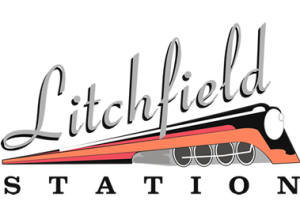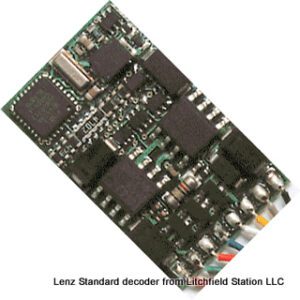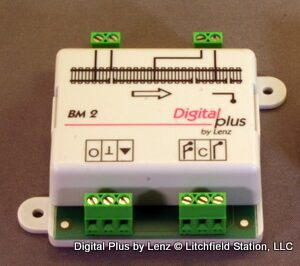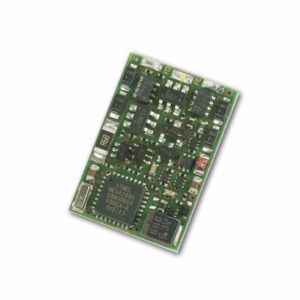Description
To use the ABC technology with BM1, BM2 and BM3 block section modules, you will need locomotive decoders of the GOLD series or other decoders that support the ABC technology.
Technical Data:
| Maximum continuous current-carrying capacity |
3.0 A |
| Voltage at signal input (AC or DC) |
DC: 11…24 V AC: 8…24 V |
| Dimensions |
70 x 60 x 20 mm |
How does the ABC technology work?
With little effort, ABC manages to accomplish just what model railway enthusiasts crave: precise on-the-spot stopping in front of signals, slow approach and passage in the opposite direction.
By means of simple modules, which supply the braking section in front of a signal, an asymmetry is created in the otherwise symmetrical digital track voltage. Naturally, this occurs only if the signal is at “Stop” or “Slow approach”. This asymmetry informs the locomotive decoder about the signal status:
A “Stop” or “Slow approach” signal indicates asymmetry – the train will stop or slow down.
A “Clear” signal indicates normal digital voltage – the train will continue.
Additional advantages of the ABC technology:
All locomotive functions (e.g. front lighting) can still be switched while the locomotive stops in front of the signal.
Programming in operational mode (POM) possible.
The locomotive can reverse away again from the signal!
A locomotive can pass in the opposite direction, even if the signal is at “Stop”.
Switching is possible, even if the signal is at “Stop”. Simply activate the switching mode!
No short-circuits when crossing section points between the driving and stopping sections.
Compared to the simple BM1, the BM2 module has the following advantages:
In addition to signal stopping, “Slow approach” (HP2) is also possible.
Easy control of the module using light signals and semaphore signals fitted with switches.
Even rear-powered (pushed) trains (push-pull trains, commuter trains, motor coaches) stop at the right spot.
Depending on the signal setting, you can use the BM2 module to direct locomotives fitted with a GOLD/ SILVER decoder to stop (for HP0), to pass (for HP1) or to slowly approach (for HP2). Of course, you can set the speed for the slow approach in the locomotive decoder.
The BM2 has two control inputs. Depending on which one is active, the BM2 sends the information “STOP or “SLOW APPROACH” to the locomotive equipped with the GOLD decoder.
Rear-powered trains (pushed) and push-pull (commuter) trains? – no problem!
Would you also like to use the “Signal stop” and “Slow approach” functions for rear-powered (pushed) trains and push-pull (commuter) trains?
Divide the section in front of the signal into a driving (A) and a braking section (B).
When the rear-powered (pushed) train in the driving section reaches the braking section, the BM2 switches the driving and braking sections to asymmetrical digital voltage. As the pushing locomotive is already located in the driving section at that time, the GOLD decoder recognises this asymmetry and switches to “Stop” or “Slow approach”, depending on the signal setting.
The length of the driving section must be calculated so as to fully accommodate the longest trains passing this section. The length of the braking section depends on the braking delay and/or distance set in the locomotive decoder.
Trains passing in the opposite direction do not initiate a braking procedure.The above procedure requires that the leading coach of the rear-powered (pushed) train is fitted with a power consuming device, e.g. interior lighting.
Additional information
| Weight | .3 lbs |
|---|





